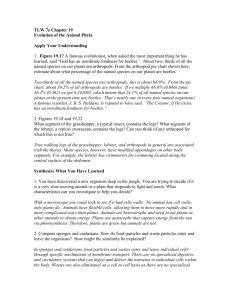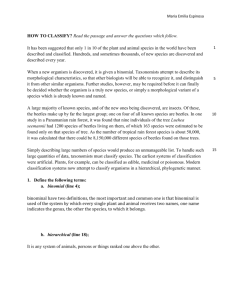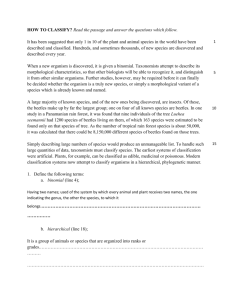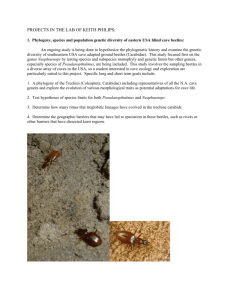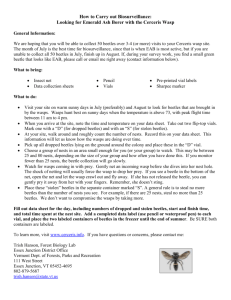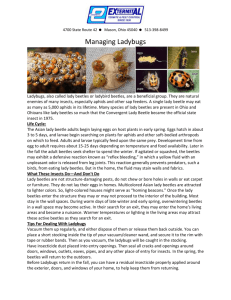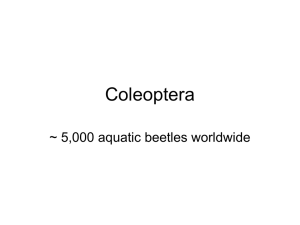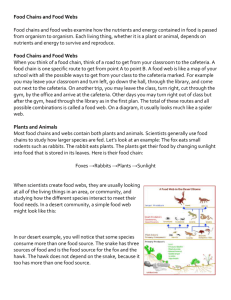Diversity of Saproxylic Beetles in the Past, as Represented in the
advertisement
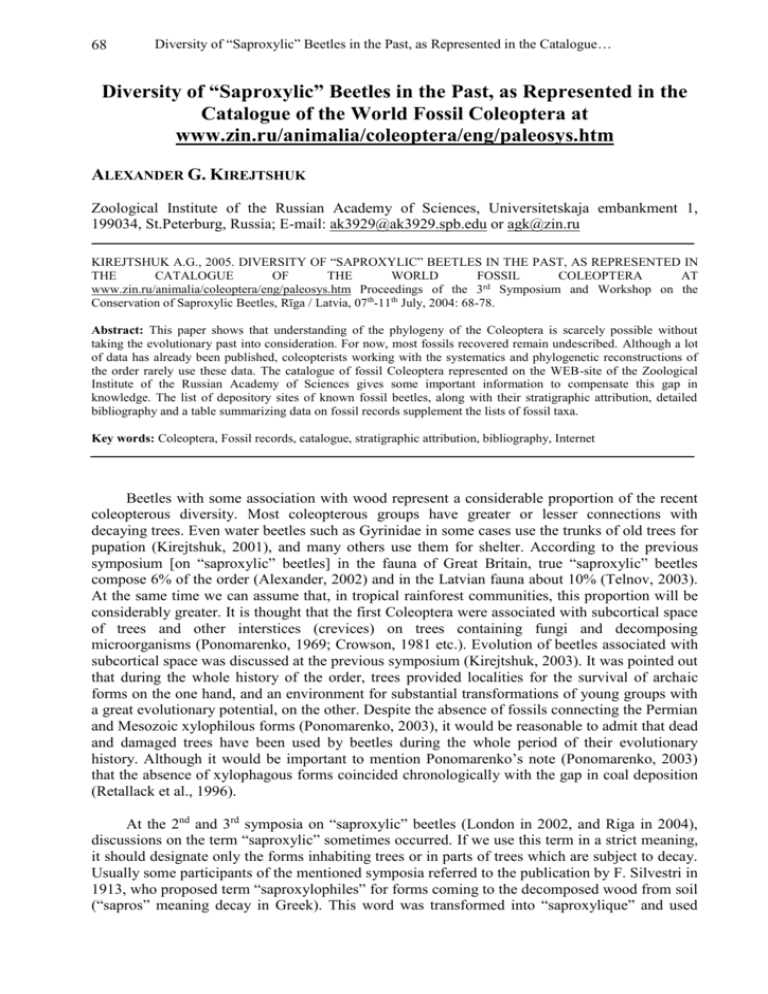
68 Diversity of “Saproxylic” Beetles in the Past, as Represented in the Catalogue… Diversity of “Saproxylic” Beetles in the Past, as Represented in the Catalogue of the World Fossil Coleoptera at www.zin.ru/animalia/coleoptera/eng/paleosys.htm ALEXANDER G. KIREJTSHUK Zoological Institute of the Russian Academy of Sciences, Universitetskaja embankment 1, 199034, St.Peterburg, Russia; E-mail: ak3929@ak3929.spb.edu or agk@zin.ru KIREJTSHUK A.G., 2005. DIVERSITY OF “SAPROXYLIC” BEETLES IN THE PAST, AS REPRESENTED IN THE CATALOGUE OF THE WORLD FOSSIL COLEOPTERA AT www.zin.ru/animalia/coleoptera/eng/paleosys.htm Proceedings of the 3rd Symposium and Workshop on the Conservation of Saproxylic Beetles, Rīga / Latvia, 07th-11th July, 2004: 68-78. Abstract: This paper shows that understanding of the phylogeny of the Coleoptera is scarcely possible without taking the evolutionary past into consideration. For now, most fossils recovered remain undescribed. Although a lot of data has already been published, coleopterists working with the systematics and phylogenetic reconstructions of the order rarely use these data. The catalogue of fossil Coleoptera represented on the WEB-site of the Zoological Institute of the Russian Academy of Sciences gives some important information to compensate this gap in knowledge. The list of depository sites of known fossil beetles, along with their stratigraphic attribution, detailed bibliography and a table summarizing data on fossil records supplement the lists of fossil taxa. Key words: Coleoptera, Fossil records, catalogue, stratigraphic attribution, bibliography, Internet Beetles with some association with wood represent a considerable proportion of the recent coleopterous diversity. Most coleopterous groups have greater or lesser connections with decaying trees. Even water beetles such as Gyrinidae in some cases use the trunks of old trees for pupation (Kirejtshuk, 2001), and many others use them for shelter. According to the previous symposium [on “saproxylic” beetles] in the fauna of Great Britain, true “saproxylic” beetles compose 6% of the order (Alexander, 2002) and in the Latvian fauna about 10% (Telnov, 2003). At the same time we can assume that, in tropical rainforest communities, this proportion will be considerably greater. It is thought that the first Coleoptera were associated with subcortical space of trees and other interstices (crevices) on trees containing fungi and decomposing microorganisms (Ponomarenko, 1969; Crowson, 1981 etc.). Evolution of beetles associated with subcortical space was discussed at the previous symposium (Kirejtshuk, 2003). It was pointed out that during the whole history of the order, trees provided localities for the survival of archaic forms on the one hand, and an environment for substantial transformations of young groups with a great evolutionary potential, on the other. Despite the absence of fossils connecting the Permian and Mesozoic xylophilous forms (Ponomarenko, 2003), it would be reasonable to admit that dead and damaged trees have been used by beetles during the whole period of their evolutionary history. Although it would be important to mention Ponomarenko’s note (Ponomarenko, 2003) that the absence of xylophagous forms coincided chronologically with the gap in coal deposition (Retallack et al., 1996). At the 2nd and 3rd symposia on “saproxylic” beetles (London in 2002, and Riga in 2004), discussions on the term “saproxylic” sometimes occurred. If we use this term in a strict meaning, it should designate only the forms inhabiting trees or in parts of trees which are subject to decay. Usually some participants of the mentioned symposia referred to the publication by F. Silvestri in 1913, who proposed term “saproxylophiles” for forms coming to the decomposed wood from soil (“sapros” meaning decay in Greek). This word was transformed into “saproxylique” and used Proceedings of the 3rd Symposium and Workshop on the Conservation of Saproxylic Beetles Rīga / Latvia, 07th-11th July, 2004: 68-78. 69 similarly by R. Dajoz (1966, etc.). Such an interpretation of the term is quite correct in the semantic sense. Later R. Dajoz (2000, etc.) somewhat increased the meaning of this term by adding to such forms species associated with dry wood. Nevertheless, his concept remains comparable with the initial one. Some recent workers changed the meaning of this word still more in a new combination “saproxylic complex”, including all the components, which could visit dead trees and their parts (except for foliage and inflorescences). If the “saproxylic complex” is to be regarded as a strict term, the “saproxylic species” can give the wrong impression. Excepting some specialized species, very frequently the forms which are more or less characteristic of dead decaying tree parts, can also live in damaged, but still living trees with sap exuding and being fermented by yeast and microbes. On the other hand, it is difficult to apply this term to predaceous forms, which regularly visit such habits, but have no obligatory association with them. In different presentations of both the mentioned symposia, some authors considered among “saproxylic” taxa even species that are certainly associated with soil fungi. Figure 1. Page with index of divisions of the site. Thus, this term seems to have become rather devalued and unclear. Perhaps, it would be advisable in many cases to use the nomenclature developed in the beginning and middle of the last century, and still recognized among many entomologists and specialists in forestry (including R. Dajoz in the publications discussed; Mamaev, 1977, etc.), which is composed of 3 semantic roots: first indicating the substrate of inhabitation, second the substrate of feeding, and finally the suffix “phage” or “biont”. Not infrequently, regular visitors to decaying wood could be called “xylomycetophages” or “xylomycetobiontes”, meaning that they live in wood and feed on fungal components in this substrate. Consistently the term “saproxylomycetophages” or “saproxylomycetobiontes” are applied to forms which would have been referred to by F. Silvestri as “saproxylophiles”. “Saproxylic” can be applied to assemblages of insects in certain habits, but it would be better to indicate individual species using a more concrete term. 70 Diversity of “Saproxylic” Beetles in the Past, as Represented in the Catalogue… It seems to be appropriate to draw the attention of specialists on xylobiotic (xylobious) beetles to the resources of data that is quite important to explain ecological processes, their origin and changes in time. I have in view the historical aspect of consideration of interactions between insects and wood substrate. In some sense this report is a continuation and illustration for the presentation at the 2nd symposium in London (Kirejtshuk, 2003). This material has already been posted on the website “Beetles (Coleoptera) and coleopterists” (Fig. 1. http://www.zin.ru/Animalia/Coleoptera/eng/index.htm) and has potential for future improvement. Figure 2. Page with a review on historical development of the order. On this site two years ago in the division “Taxonomy and phylogeny” we began to develop pages with palaeontological information and databases. There are presented some various pages. One page is devoted to a large paper by A.G. Ponomarenko containing a review of the fossil records and the historical development of the order up to the Pleistocene, with some methodological comments by the author (Fig. 2. http://www.zin.ru/Animalia/Coleoptera/eng/syst4.htm). Others include a paper by S.A. Kuzmina and a paper by E.V. Zinoviev on the Quaternary beetles, with a large list of references (Fig. 3. http://www.zin.ru/Animalia/Coleoptera/rus/kuzmina1.htm - I am obliged to refer to some pages from the Russian version of the site, which at present is much more complete than the English one, because of different rates of preparation of these two versions). Besides, the most important pages are devoted to the catalogue of the fossil records of Coleoptera (Fig. 4. http://www.zin.ru/Animalia/Coleoptera/eng/paleosys.htm) known from publications, and also data recovered and defined by the authors of this catalogue. The catalogue consists of 4 parts with a list of recorded taxa (Fig. 5. - http://www.zin.ru/Animalia/Coleoptera/eng/paleosy0.htm). Proceedings of the 3rd Symposium and Workshop on the Conservation of Saproxylic Beetles Rīga / Latvia, 07th-11th July, 2004: 68-78. 71 Figure 3. Page with paper on the Quaternary insects. Each taxon in this list is supplied with stratigraphic attribution and localities, where the earliest and latest records of a given taxon have been found. In case where any taxon is known from only one finding, it is provided with an indication to only one age and one locality. In cases where a taxon is known in the recent fauna, it is indicated by the capital letter “R” (Fig. 6. http://www.zin.ru/Animalia/Coleoptera/eng/paleosy2.htm). The main synonyms for the taxa above the generic level and all synonyms of generic and species taxa are mentioned in all cases. The catalogue also includes all known ichnotaxa, i.e. names proposed for remnants of living activity of ancient beetles. In order to reach an easy estimation of the position of any generic taxon included in the catalogue, it contains not only the names of all family taxa, but also the names of subfamily taxa and in some cases tribe and even subtribe taxa used by specialists in each large group. As a special supplement to the list of taxa, a register is provided with all known sites of deposition (Fig. 7. - http://www.zin.ru/Animalia/Coleoptera/eng/paleoloc.htm), where fossil beetles have been collected. Moreover, the catalogue also contains references to the publications (Fig. 8. - http://www.zin.ru/Animalia/Coleoptera/eng/paleolit.htm) with description of the fossil taxa, and the publications that consider problems of phylogeny and historical development. Particular pages summarize the data of the catalogue showing the distribution of all coleopterous families through time (Fig. 9. http://www.zin.ru/Animalia/Coleoptera/rus/tabla.htm). Reliable records are shown in dark grey color, but light grey and blue colors mean that some doubtful data on any group are known, but some of them should be additionally checked and others should be ignored. Unfortunately some data published in connection with consideration of phylogeny of some groups have not been provided with any real evidence, and are based on only some interpretations of morphological characters or some theoretical speculations of the writers concerned. At the same time some ichnotaxa present quite reliable indications of the existence of some groups of organisms. For 72 Diversity of “Saproxylic” Beetles in the Past, as Represented in the Catalogue… example, the remnants of scolytid holes in tree trunks of the Cretaceous age are quite reliable because of their clearly visible, characteristic configuration, although the beetles that produced such holes have only been recorded in the sites with Cainozoic deposits, where they are well represented and rather abundant as inclusions of the Baltic amber. Figure 4. Page with introduction to the catalogue. Thus, it is a quite delicate matter to interpret the known fossil records correctly. The general opinion of many biologists dealing with research on recent specimens, that fossil records are full of gaps, needs many specifications. On the other hand, most records already obtained in different collections remain unpublished or were published with wrong interpretations and, therefore, need to be revised. In order to reach an adequate level of interpretation, firstly the conditions of deposition of insects, and any possible transformations which may have happened while the remains were in their sites of deposition, have to be taken into account. Main types of assemblages of deposited remains of organisms accessible for study came from sedimentary deposits in water basins and inclusions in fossil resin. Animals and other organisms can be also preserved in peat, volcanic ash, asphalt morasses and under other conditions, though the quantity of such fossils is small and their state of preservation generally poor. Besides, the composition of taxa preserved in carbonates and amber with the same age can scarcely coincide; the occurrence of insect fossils in sediment that also yields insect-bearing resin is extremely rare (MartínezDeclòs et al., 2004, etc.). The available assemblages of fossil insects depend not only on a certain faunal composition of the place where they were formed at a certain time, but also on the deposition environment and diagenic history. The places of insect deposition, which can be found in carbonate rocks, often represent the former bottoms of ancient water basins (fresh water basins and marine lagoons) that accumulated flood animals. Most remains in such sites belong to aquatic and actively flying insects. Wingless insects and species living mostly in soil or on the ground, especially in arid areas, are much less Proceedings of the 3rd Symposium and Workshop on the Conservation of Saproxylic Beetles Rīga / Latvia, 07th-11th July, 2004: 68-78. 73 likely to be preserved there. Xylobiotic beetles occur in these sites in lower proportions than their representation in the past terrestrial faunas. The data from these sites are the main source of information on fossils. The second resource for the study of coleopterous fossils contains mostly the species associated with trees and forests. This is particularly important for small xylobiotic beetles, which very quickly became covered with liquid resin. However, larger insects were contacting the resin only with a part of their sclerites and, therefore, in some or many cases they were able to escape. As a result, this resource is also not properly representative. Although, careful analysis of data from both resources, as well as after taking into consideration probable interconnections between different organisms at the considered period, we can obtain a comparatively confident impression of the xylobiotic fauna of a certain geological period. Figure 5. Page with the first list of fossil taxa. In addition to the catalogue on the website, the pages of the atlas of fossil beetles started to develop as well. This atlas is planned in accordance with the general system of the order. It has the usual systematic hierarchy from the general scheme of superfamilies, leading to the pages with family composition of each superfamily (Fig. 10. http://www.zin.ru/Animalia/Coleoptera/eng/fossils.htm) and further to the pages for every particular family with main characteristics of the known fossil records on these families. On each page devoted to a particular family, one picture or pictures of some impressive specimens of it are provided. (Fig. 11. - http://www.zin.ru/Animalia/Coleoptera/rus/coptcl_f.htm). Here is shown one specimen of Coptoclavidae, the extinct group of water beetles with faceted eyes divided horizontally, like those of recent Gyrinidae, and also with prehensile anterior legs and with swimming or running intermediate and posterior legs. 74 Diversity of “Saproxylic” Beetles in the Past, as Represented in the Catalogue… Figure 6. Page with the third list of fossil taxa. Figure 7. Page with the list of the known sites with deposited insects. Proceedings of the 3rd Symposium and Workshop on the Conservation of Saproxylic Beetles Rīga / Latvia, 07th-11th July, 2004: 68-78. Figure 8. The table of distribution of coleopterous families in time. Figure 9. Page with bibliography on extinct beetles. 75 76 Diversity of “Saproxylic” Beetles in the Past, as Represented in the Catalogue… There is no other way to define if a group of extinct beetles was xylobiotic, except the principle of “actualization”. The groups which recently are xylobiotic were very probably xylobiotic in the past as well, or, if any extinct group demonstrates some features characteristic of recent xylobiotic groups, this extinct group can be regarded as xylobiotic with a certain probability. Such conclusions were reached after the study of the earliest coleopterous fossils, and many other Permian beetles. Respectively, conclusions on a non-xylobiotic mode of life for some extinct Upper Permian and Mesozoic groups was reached after analyses of the structural characters of their remains, which can be interpreted as an evidence of a mode of life in or near water. Figure 10. Page on family Coptoclavidae. The catalogue and table of distribution of all coleopterous families through time show that the Palaeozoic groups scarcely have clear links with the Meso- and Cainozoic Coleoptera. Only in the Middle Triassic the first xylobiotic groups which are represented in the recent fauna appeared (members of the suborder Archostemata) and later (in the Upper Triassic) the first possible xylobiotic Polyphaga appeared in depositions of known sites. They show that the evolution of Meso- and Cainozoic Coleoptera was characterized by a gradual dislodging of more ancient groups by groups of more recent appearance. There are not very many palaeorelict Mesozoic groups known which have completely disappeared. Only the Schizophoroid lineage and some separate families from different superfamilies did not survive until the recent epoch. However, some palaeocoleopterists consider that this lineage could have produced the recent families of Myxophaga (Ponomarenko, 2003, etc.). Unfortunately, fossil record has not received sufficient attention from coleopterists and, as was mentioned before, most material still waits in different collections to be studied and published. Therefore, a lot of work is needed in order to reach any adequate presentation of the data already available in the collections, in scientific publications, and on the pages of the website Proceedings of the 3rd Symposium and Workshop on the Conservation of Saproxylic Beetles Rīga / Latvia, 07th-11th July, 2004: 68-78. 77 “Beetles (Coleoptera) and coleopterists”. Every contribution to this important field of knowledge would be welcomed. Nevertheless, some tendencies can be traced even at the current level of knowledge of ancient xylobiotic beetles. The xylophilous Archostemata, rather numerous in the Mesozoic era, are represented by only a few relicts in recent ecosystems. The number of Elateridae and some other groups of Elateriformia (like Ptilodactylidae, Eucinetidae and probably related families) seems to have decreased towards the end of the Cretaceous and particularly in the Cainozoic era, while their proportion were significantly diminished due to the intensive diversification of different Cucujiformia. However, Peltidae and some other Cucujiform groups (e.g., Mordellidae) were rather common in the past, like the mentioned elateriforms, but also became quite rare recently. In contrast to the groups mentioned, the xylobiontic Buprestidae and Scarabaeoidea appeared in the Middle or Upper Jurassic, became rather abundant through the Cretaceous, and thus produced certain changes in the taxonomic composition of saproxylic and other xylophilous communities. The same is true of the superfamily Cucujoidea, which appeared in fossil records only in the Cretaceous (except for Parandrexidae recorded from the Middle Jurassic). Figure 11. First page of the Atlas of extinct forms of beetles. Acknowledgements It is the pleasant duty of the author to express his sincere recognition of the people who contributed data for the discussed palaeontological pages on the site "Beetles (Coleoptera) and coleopterists", and firstly to express acknowledgement of the authors of these pages (A.G. Ponomarenko, V.V. Zherikhin, C. Soriano, S.A. Kuzmina, E.V. Zinoiev and others) and the photographers (D.E. Shcherbakov, I.M. Verdu, P.V. Korsunovich and others). The general development of the site was supported by the Russian Foundation for Basic Research (grant Nr 02-07-90105) and the development of the palaeontological partition of this site was additionally 78 Diversity of “Saproxylic” Beetles in the Past, as Represented in the Catalogue… supported by the grant of the Presidium of the Russian Academy of Sciences according to the programme "Origin and evolution of biosphere". The author's particular thanks go to all members of the Editorial Board of the site and particularly to A.L. Lobanov (ZIN, St.-Petersburg) and D. Telnov (The Entomological Society of Latvia, Rīga). The author recognizes the assistance of M.V.L. Barclay (The Natural History Museum in London) in correcting the English. References ALEXANDER K.N.A., 2002. The invertebrates of living and decaying timber in Britain and Ireland. Provisional annotated checklist. - English Nature Research Reports 467: 1-142. CROWSON R.A., 1981. The Biology of the Coleoptera. Academic Press, London, New York, Toronto, Sydney, San Francisco: i-xii + 1-802. DAJOZ R., 1966. Ecologie et biologie des coléoptères xylophages de la hetraie. - Vie et Milieu 17: 525-763. DAJOZ R., 2000. Insects and forests. The role and diversity of insects in the forest environment. Technique et documentation, Londres, Paris, New York: 1-668. KIREJTSHUK A.G., 2001. Semeystvo Gyrinidae (vertyachki) [Family Gyrinidae (whirligig beetles)]. In: TZALOLIKHIN S.J. (ed.) 2001. Opredelitel’ presnovodnykh bespozvonochnykh Rossii i sopredel’nykh stran 5 [Key to freshwater invertebrates of Russia and adjacent lands 5]. Nauka, Saint Petersburg: 1-838 [in Russian]. KIREJTSHUK A.G., 2003. Subcortical space as an environment for palaeoendemic and young groups of beetles, using mostly examples from sap-beetles (Nitidulidae, Coleoptera). In: BOWEN C.P. (ed.) Proceedings of the second pan-European conference on Saproxylic Beetles. People’s Trust for Endangered Species, London: 50-56. MAMAEV B.M., 1977. Biologiya nasekomykh-razrushiteley drevesiny [Bilogy of insectsdestructors of timber]. In: Itogi nauki I tekhniki. Entomologia [Achievements of science and technique]. Moscow: 1-214 [in Russian]. MARTÍNES-DECLÒS X., BRIGGS D.E.G., PEÑALVER E., 2004. Taphonomy of insects in carbonates and amber. - Palaeo: palaeogeography, palaeoclimatology, palaeoecology 203: 19-64. PONOMARENKO A.G., 1969. Istoricheskoye razvitie zhestkokrylykh-arkhostemat [Historical development of the Archostematan beetles]. - Trudy paleontologicheskogo instituta AN SSSR [Proceedings of the Palaeontological Institute of the USSR Ac. Sci.] 125: 1-233. PONOMARENKO A.G., 2003. Ecological evolution of beetles (Insecta: Coleoptera). - Acta zoologica cracoviensia 46, supplementum – Fossil Insects: 319-328. RETALLACK G.J., VEEVERS J.J., MORANTE R., 1996. Global coal gap between Permian-triassic extinction and Middle Triassic recovery of peat-forming plants. - Bulletin of the Geological Society of America 108: 195-207. SILVESTRI F., 1913. Descripzione di un nuove ordine di insetti. - Bolletino del Laboratorio di Zoologia generale e agraria della R. Sciola superiore d'Agricola in Portici 7: 192-209. TELNOV D., 2003. Saproxylic Latvia - the situation, species diversity and possibilities. In: BOWEN C.P. (ed.) Proceedings of the second pan-European conference on Saproxylic Beetles. People’s Trust for Endangered Species, London: 39-40.

